Seasonal Divergent Tree Growth Trends and Growth Variability along Drought Gradient over Northeastern China
Abstract
:1. Introduction
2. Materials and Methods
2.1. Study Region
2.2. Datasets
2.2.1. Tree Growth Proxies and Land Cover Data
2.2.2. Climate Data
2.3. Data Analyses
2.3.1. TRI Chronology
2.3.2. Statistical Analysis
3. Results
3.1. Seasonal Trends in Tree Growth and Climate Response
3.2. The Spatiotemporal Pattern in Tree Growth Variability and the Potential Drivers
4. Discussion
4.1. Divergent Tree Growth Trends in Different Seasons
4.2. Tree Growth Variability and Drought Adaptation of Temperate Forests
5. Conclusions
Supplementary Materials
Author Contributions
Funding
Acknowledgments
Conflicts of Interest
References
- Zhu, X.L.; Liu, D.S. Improving forest aboveground biomass estimation using seasonal landsat ndvi time-series. Lsprs J. Photogram. Remote Sens. 2015, 102, 222–231. [Google Scholar] [CrossRef]
- Houghton, R.A. Aboveground forest biomass and the global carbon balance. Glob. Chang. Biol. 2005, 11, 945–958. [Google Scholar] [CrossRef]
- Canadell, J.G.; Raupach, M.R. Managing forests for climate change mitigation. Science 2008, 320, 1456–1457. [Google Scholar] [CrossRef] [PubMed]
- Zhu, Z.C.; Piao, S.L.; Myneni, R.B.; Huang, M.T.; Zeng, Z.Z.; Canadell, J.G.; Philippe, C.; Sitch, S.; Friedlingstein, P.; Arneth, A.; et al. Greening of the earth and its drivers. Nat. Clim. Chang. 2016, 6, 791–795. [Google Scholar] [CrossRef]
- Bonan, G.B.; Doney, S.C. Climate, ecosystems, and planetary futures: The challenge to predict life in earth system models. Science 2018, 359. [Google Scholar] [CrossRef] [PubMed]
- Hinzman, L.D.; Bettez, N.D.; Bolton, W.R.; Chapin, F.S.; Dyurgerov, M.B.; Fastie, C.L.; Griffith, B.; Hollister, R.D.; Hope, A.; Huntington, H.P.; et al. Evidence and implications of recent climate change in northern alaska and other arctic regions. Clim. Chang. 2005, 72, 251–298. [Google Scholar] [CrossRef]
- Kong, D.D.; Zhang, Q.; Singh, V.P.; Shi, P.J. Seasonal vegetation response to climate change in the Northern Hemisphere (1982–2013). Glob. Planet. Chang. 2017, 148, 1–8. [Google Scholar] [CrossRef]
- Allen, C.D.; Breshears, D.D.; Mcdowell, N.G. On underestimation of global vulnerability to tree mortality and forest die-off from hotter drought in the anthropocene. Ecosphere 2016, 6, 1–55. [Google Scholar] [CrossRef]
- Anderegg, W.R.L.; Klein, T.; Bartlett, M.; Sack, L.; Pellegrini, A.F.A.; Choat, B.; Jansen, S. Meta-analysis reveals that hydraulic traits explain cross-species patterns of drought-induced tree mortality across the globe. Proc. Natl. Acad. Sci. USA 2016, 113, 5024–5029. [Google Scholar] [CrossRef] [PubMed]
- McDowell, N.G.; Williams, A.P.; Xu, C.; Pockman, W.T.; Dickman, L.T.; Sevanto, S.; Pangle, R. Multi-scale predictions of massive conifer mortality due to chronic temperature rise. Nat. Clim. Chang. 2016, 6, 295–300. [Google Scholar] [CrossRef]
- Greenwood, S.; Ruiz-Benito, P.; Martinez-Vilalta, J.; Lloret, F.; Kitzberger, T.; Allen, C.D.; Fensham, R.D.C.; Kattge, J.; Bönisch, G.; Kraft, N.J. Tree mortality across biomes is promoted by drought intensity, lower wood density and higher specific leaf area. Ecol. Lett. 2017, 20, 539–553. [Google Scholar] [CrossRef] [PubMed] [Green Version]
- Gazol, A.; Camarero, J.J.; Anderegg, W.R.L.; Vicente-Serrano, S.M. Impacts of droughts on the growth resilience of northern hemisphere forests. Glob. Ecol. Biogeogr. 2017, 26, 166–176. [Google Scholar] [CrossRef]
- Moreno-Gutiérrez, C.; Dawson, T.E.; Nicolás, E.; Querejeta, J.I. Isotopes reveal contrasting water use strategies among coexisting plant species in a mediterranean ecosystem. New Phytol. 2012, 196, 489–496. [Google Scholar] [CrossRef] [PubMed]
- Klein, T.; Yakir, G.D.; Körner, C. Drought stress, growth and nonstructural carbohydrate dynamics of pine trees in a semi-arid forest. Tree Physiol. 2014, 34, 981–992. [Google Scholar] [CrossRef] [PubMed] [Green Version]
- Yang, B.; Wen, X.F.; Sun, X.M. Seasonal variations in depth of water uptake for a subtropical coniferous plantation subjected to drought in an East Asian monsoon region. Agric. For. Meteorol. 2015, 201, 218–228. [Google Scholar] [CrossRef]
- Sun, J.; Qin, X.J. Precipitation and temperature regulate the seasonal changes of NDVI across the Tibetan Plateau. Environ. Earth Sci. 2016, 75, 1–9. [Google Scholar] [CrossRef]
- Piao, S.L.; Fang, J.Y.; Zhou, L.M.; Ciais, P.; Zhu, B. Variations in satellite-derived phenology in china’s temperate vegetation. Glob. Chang. Biol. 2010, 12, 672–685. [Google Scholar] [CrossRef]
- Shen, M.G.; Piao, S.L.; Dorji, T.; Liu, Q.; Cong, N.; Chen, X.Q.; An, S.; Wang, S.; Wang, T.; Zhang, G. Plant phenological responses to climate change on the Tibetan Plateau: Research status and challenges. Nat. Sci. Rev. 2015, 2, 454–467. [Google Scholar] [CrossRef]
- Zhao, M.; Dirmeyer, P.A. Pattern and trend analysis of temperature in a set of seasonal ensemble simulations. Geophys. Res. Lett. 2003, 311, 293–317. [Google Scholar] [CrossRef]
- Wang, S.Y.; Wang, X.Y.; Chen, G.S.; Yang, Q.C.; Wang, B.; Ma, Y.X.; Shen, M. Complex responses of spring alpine vegetation phenology to snow cover dynamics over the Tibetan Plateau, China. Sci. Total Environ. 2017, 593–594, 449–461. [Google Scholar] [CrossRef]
- Luo, X.Z.; Chen, X.Q.; Wang, L.X.; Xu, L.; Tian, Y.H. Modeling and predicting spring land surface phenology of the deciduous broadleaf forest in northern china. Agric. For. Meteorol. 2014, 198–199, 33–41. [Google Scholar] [CrossRef]
- Fan, X.G.; Ma, Z.G.; Yang, Q.; Han, Y.H.; Mahmood, R. Land use/land cover changes and regional climate over the loess plateau during 2001–2009, part II: Interrelationship from observations. Clim. Chang. 2015, 129, 441–455. [Google Scholar] [CrossRef]
- Liu, J.C.; Wu, B.G.; Chen, D. Improvement and compilation of density management diagram of larix principis-rupprechtii mayr forest in Northern Hebei. Nat. Environ. Pollut. Technol. 2017, 16, 1271–1277. [Google Scholar]
- Bai, Y.F.; Wu, J.G.; Xing, Q.; Pan, Q.M.; Huang, J.H.; Yang, D.L.; Han, X.G. Primary production and rain use efficiency across a precipitation gradient on the Mongolia Plateau. Ecology 2008, 89, 2140. [Google Scholar] [CrossRef] [PubMed]
- Wu, X.C.; Li, X.Y.; Liu, H.Y.; Ciais, P.; Li, Y.Q.; Xu, C.Y.; Huang, Y.M. Uneven winter snow influence on tree growth across temperate China. Glob. Chang. Biol. 2019, 25, 144–154. [Google Scholar] [CrossRef]
- Liu, H.Y.; Park, W.A.; Allen, C.D.; Guo, D.L.; Wu, X.C.; Anenkhonov, O.; Liang, E.Y.; Sandanov, D.V.; Yin, Y.; Qi, Z.; et al. Rapid warming accelerates tree growth decline in semi-arid forests of Inner Asia. Glob. Chang. Biol. 2013, 19, 2500–2510. [Google Scholar] [CrossRef] [PubMed]
- Zhang, Y.; Peng, C.H.; Li, W.Z.; Tian, L.X.; Zhu, Q.; Chen, H.; Fang, X.Q.; Zhang, G.; Liu, G.; Mu, X.; et al. Multiple afforestation programs accelerate the greenness in the ‘three north’ region of china from 1982 to 2013. Ecol. Indic. 2016, 61, 404–412. [Google Scholar] [CrossRef]
- Grossiord, C.; Sevanto, S.; Adams, H.D.; Collins, A.D.; Dickman, L.T.; McBranch, N.; Michaletz, S.; Stockton, E.A.; Vigil, M.; McDowell, N.G. Precipitation, not air temperature, drives functional responses of trees in semi-arid ecosystems. J. Ecol. 2017, 105, 163–175. [Google Scholar] [CrossRef]
- Hua, T.; Wang, X.M.; Zhang, C.X.; Lang, L.L.; Li, H. Responses of Vegetation Activity to Drought in Northern China. Land Degrad. Dev. 2017, 28, 1913–1921. [Google Scholar] [CrossRef]
- Tucker, C.J.; Pinzon, J.E.; Brown, M.E.; Slayback, D.A.; Pak, E.W.; Mahoney, R.; Vermote, E.F.; El Saleous, N. An extended AVHRR 8-km NDVI dataset compatible with MODIS and SPOT vegetation NDVI data. Int. J. Remote Sens. 2005, 26, 4485–4498. [Google Scholar] [CrossRef]
- Alcaraz-Segura, D.O.M.I.N.G.O.; Chuvieco, E.; Epstein, H.E.; Kasischke, E.S.; Trishchenk, A. Debating the greening vs. browning of the North American boreal forest: Differences between satellite datasets. Glob. Chang. Biol. 2010, 16, 760–770. [Google Scholar] [CrossRef]
- Guay, K.C.; Beck, P.S.; Berner, L.; Goetz, T.S.J.; Baccini, A.; Buermann, W. Vegetation productivity patterns at high northern latitudes: A multi-sensor satellite data assessment. Glob. Chang. Biol. 2014, 20, 3147–3158. [Google Scholar] [CrossRef] [PubMed]
- Shi, F.Z.; Wu, X.C.; Li, X.Y.; Chen, D.L.; Liu, H.Y.; Liu, S.M.; Hu, X.; He, B.; Shi, C.; Wang, P.; et al. Weakening relationship between vegetation growth over the Tibetan Plateau and large-scale climate variability. J. Geophys. Res. Biogeosci. 2018, 123, 1247–1259. [Google Scholar] [CrossRef]
- Wu, X.C.; Liu, H.Y.; Guo, D.L.; Anenkhonov, O.A.; Badmaeva, N.K.; Sandanov, D.V. Growth decline linked to warming-induced water limitation in hemi-boreal forests. PLoS ONE 2012, 7, e42619. [Google Scholar] [CrossRef] [PubMed]
- Yin, Y.H.; Ma, D.Y.; Wu, S.H.; Pan, T. Projections of aridity and its regional variability over china in the mid-21st century. Int. J. Climatol. 2016, 35, 4387–4398. [Google Scholar] [CrossRef]
- Thornthwaite, C.W. An Approach toward a Rational Classification of Climate. Geogr. Rev. 1948, 38, 55–94. [Google Scholar] [CrossRef]
- Pereira, A.R.; Pruitt, W.O. Adaptation of the Thornthwaite scheme for estimating daily reference evapotranspiration. Agric. Water Manag. 2004, 66, 251–257. [Google Scholar] [CrossRef]
- Pei, T.T.; Wu, X.C.; Li, X.Y.; Zhang, Y.; Shi, F.Z.; Ma, Y.J.; Wang, P.; Zhang, C. Seasonal divergence in the sensitivity of evapotranspiration to climate and vegetation growth in the Yellow River Basin, China. J. Geophys. Res. Biogeosci. 2017, 122, 103–118. [Google Scholar] [CrossRef]
- Liu, X.F.; Wang, S.X.; Zhou, Y.; Wang, F.T.; Yang, G.; Liu, W.L. Spatial analysis of meteorological drought return periods in china using copulas. Nat. Hazards 2016, 80, 367–388. [Google Scholar] [CrossRef]
- Liu, Q.; Yan, C.R.; Ju, H.; Garré, S. Impact of climate change on potential evapotranspiration under a historical and future climate scenario in the huang-huai-hai plain, China. Theor. Appl. Climatol. 2018, 132, 387–401. [Google Scholar] [CrossRef]
- Ma, Q.Y.; Zhang, J.Q.; Sun, C.Y.; Guo, E.L.; Zhang, F.; Wang, M.M. Changes of reference evapotranspiration and its relationship to dry/wet conditions based on the aridity index in the songnen grassland, northeast China. Water 2017, 9, 316. [Google Scholar] [CrossRef]
- Wu, X.C.; Liu, H.Y.; Li, X.Y.; Piao, S.L.; Ciais, P.; Guo, W.C.; Yin, Y.; Poulter, B.; Peng, C.; Viovy, N.; et al. Higher Temperature Variability Reduces Temperature Sensitivity of Vegetation Growth in Northern Hemisphere. Geophys. Res. Lett. 2017, 44, 6173–6181. [Google Scholar] [CrossRef]
- Holmes, R.L. Computer-assisted quality control in tree-ring dating and mea-surement. Tree-Ring Bull. 1983, 43, 69–78. [Google Scholar]
- Bunn, A.G. A dendrochronology program library in R (dplR). Dendrochronologia 2008, 26, 115–124. [Google Scholar] [CrossRef]
- Sun, W.Y.; Song, X.Y.; Mu, X.G.; Gao, P.; Wang, F.; Zhao, G.J. Spatiotemporal vegetation cover variations associated with climate change and ecological restoration in the loess plateau. Agric. For. Meteorol. 2015, 209–210, 87–99. [Google Scholar] [CrossRef]
- Kempen, M.M.L.; Smolders, A.J.P.; Bögemann, G.M.; Lamers, L.P.M.; Roelofs, J.G.M. Interacting effects of atmospheric CO2 enrichment and solar radiation on growth of the aquatic fern azolla filiculoides. Freshw. Biol. 2016, 61, 596–606. [Google Scholar] [CrossRef]
- Piao, S.L.; Yin, G.D.; Tan, J.G.; Cheng, L.; Huang, M.T.; Li, Y.; Liu, R.G.; Mao, J.; Myneni, R.B.; Peng, S.; et al. Detection and attribution of vegetation greening trend in china over the last 30 years. Glob. Chang. Biol. 2015, 21, 1601–1609. [Google Scholar] [CrossRef]
- Elliott, K.J.; Miniat, C.F.; Neil, P.; Laseter, S.H. Forest tree growth response to hydroclimate variability in the southern appalachians. Glob. Chang. Biol. 2016, 21, 4627–4641. [Google Scholar] [CrossRef]
- Paquette, A.; Vayreda, J.; Coll, L.; Messier, C.; Retana, J. Climate change could negate positive tree diversity effects on forest productivity: A study across five climate types in Spain and Canada. Ecosystems 2017, 1–11. [Google Scholar] [CrossRef]
- Charney, N.D.; Babst, F.; Poulter, B.; Record, S.; Trouet, V.M.; Frank, D.; Enquist, B.J.; Evans, M.E. Observed forest sensitivity to climate implies large changes in 21st century north American forest growth. Ecol. Lett. 2016, 19, 1119–1128. [Google Scholar] [CrossRef]
- Huang, J.P.; Yu, H.P.; Guan, X.D.; Wang, G.Y.; Guo, R.X. Accelerated dryland expansion under climate change. Nat. Clim. Chang. 2016, 6, 166. [Google Scholar] [CrossRef]
- Bhuyan, U.; Zang, C.; Menzel, A. Different responses of multispecies tree ring growth to various drought indices across europe. Dendrochronologia 2017, 44, 1–8. [Google Scholar] [CrossRef]
- Brehaut, L.; Danby, R.K. Inconsistent relationships between annual tree ring-widths and satellite-measured NDVI in a mountainous subarctic environment. Ecol. Indic. 2018, 91, 698–711. [Google Scholar] [CrossRef]
- Beck, P.S.A.; Andreuhayles, L.; D’Arrigo, R.; Anchukaitis, K.J.; Tucker, C.J.; Pinzón, J.E.; Goetz, S.J. A large-scale coherent signal of canopy status in maximum latewood density of tree rings at arctic treeline in north america. Glob. Planet. Chang. 2013, 100, 109–118. [Google Scholar] [CrossRef]
- Bunn, A.G.; Hughes, M.K.; Kirdyanov, A.V.; Losleben, M.; Vaganov, E.A. Comparing forest measurements from tree rings and a space-based index of vegetation activity in siberia. Environ. Res. Lett. 2013, 8, 035034. [Google Scholar] [CrossRef]
- Coulthard, B.L.; Touchan, R.; Anchukaitis, K.J.; Meko, D.M.; Sivrikaya, F. Tree growth and vegetation activity at the ecosystem-scale in the eastern mediterranean. Environ. Res. Lett. 2017, 12, 084008. [Google Scholar] [CrossRef]
- Brunner, I.; Herzog, C.; Dawes, M.A.; Arend, M.; Sperisen, C. How tree roots respond to drought. Front. Plant Sci. 2015, 6, 547. [Google Scholar] [CrossRef]
- Zang, C.; Hartl-Meier, C.; Dittmar, C.; Rothe, A.; Menzel, A. Patterns of drought tolerance in major european temperate forest trees: Climatic drivers and levels of variability. Glob. Chang. Biol. 2015, 20, 3767–3779. [Google Scholar] [CrossRef]
- Martin-Benito, D.; Pederson, N. Convergence in drought stress, but a divergence of climatic drivers across a latitudinal gradient in a temperate broadleaf forest. J. Biogeogr. 2015, 42, 925–937. [Google Scholar] [CrossRef]
- Wu, X.C.; Liu, H.Y.; Li, X.Y.; Ciais, P.; Babst, F.; Guo, W.C.; Zhang, C.C.; Magliulo, V.; Pavelka, M.; Liu, S.; et al. Differentiating drought legacy effects on vegetation growth over the temperate Northern Hemisphere. Glob. Chang. Biol. 2017, 24, 504–516. [Google Scholar] [CrossRef] [Green Version]
- Schippers, P.; Sterck, F.; Vlam, M.; Zuidema, P.A. Tree growth variation in the tropical forest: Understanding effects of temperature, rainfall and CO2. Glob. Chang. Biol. 2015, 21, 2749–2761. [Google Scholar] [CrossRef] [PubMed]
- Anderegg, W.R. Spatial and temporal variation in plant hydraulic traits and their relevance for climate change impacts on vegetation. New Phytol. 2015, 205, 1008–1014. [Google Scholar] [CrossRef] [PubMed]
- López, R.; Cano, F.J.; Choat, B.; Cochard, H.; Gil, L. Plasticity in vulnerability to cavitation of pinus canariensis occurs only at the driest end of an aridity gradient. Front. Plant Sci. 2016, 7, 769. [Google Scholar] [CrossRef] [PubMed]
- Meir, P.; Wood, T.E.; Galbraith, D.R.; Brando, P.M.; Costa, A.C.L.D.; Rowland, L.; Ferreira, L.V. Threshold responses to soil moisture deficit by trees and soil in tropical rain forests: Insights from field experiments. Bioscience 2015, 65, 882–892. [Google Scholar] [CrossRef] [PubMed]
- Cárcer, P.S.D.; Vitasse, Y.; Peñuelas, J.; Jassey, V.E.J.; Buttler, A.; Signarbieux, C. Vapor-pressure deficit and extreme climatic variables limit tree growth. Glob. Chang. Biol. 2017, 24, 1108–1122. [Google Scholar] [CrossRef] [PubMed]
- Fyllas, N.M.; Bentley, L.P.; Shenkin, A.; Asner, G.P.; Atkin, O.K.; Dã-Az, S.; Enquist, B.J.; Farfan-Rios, W.; Gloor, E.; Guerrieri, R.; et al. Solar radiation and functional traits explain the decline of forest primary productivity along a tropical elevation gradient. Ecol. Lett. 2017, 20, 730–740. [Google Scholar] [CrossRef] [PubMed]
- Raczka, B.; Biraud, S.C.; Ehleringer, J.R.; Lai, C.T.; Miller, J.B.; Pataki, D.E.; Saleskaet, S.R.; Torn, M.S.; Vaughn, B.H.; Wehr, R.; et al. Does vapor pressure deficit drive the seasonality of δ13C of the net land—Atmosphere CO2 exchange across the united states? J. Geophys. Res. Biogeosci. 2017, 122, 1968–1987. [Google Scholar] [CrossRef]
- Aloni, R. Ecophysiological implications of vascular differentiation and plant evolution. Trees 2015, 29, 1–16. [Google Scholar] [CrossRef]
- Marqués, L.; Camarero, J.J.; Gazol, A.; Zavala, M.A. Drought impacts on tree growth of two pine species along an altitudinal gradient and their use as early-warning signals of potential shifts in tree species distributions. For. Ecol. Manag. 2016, 381, 157–167. [Google Scholar] [CrossRef]


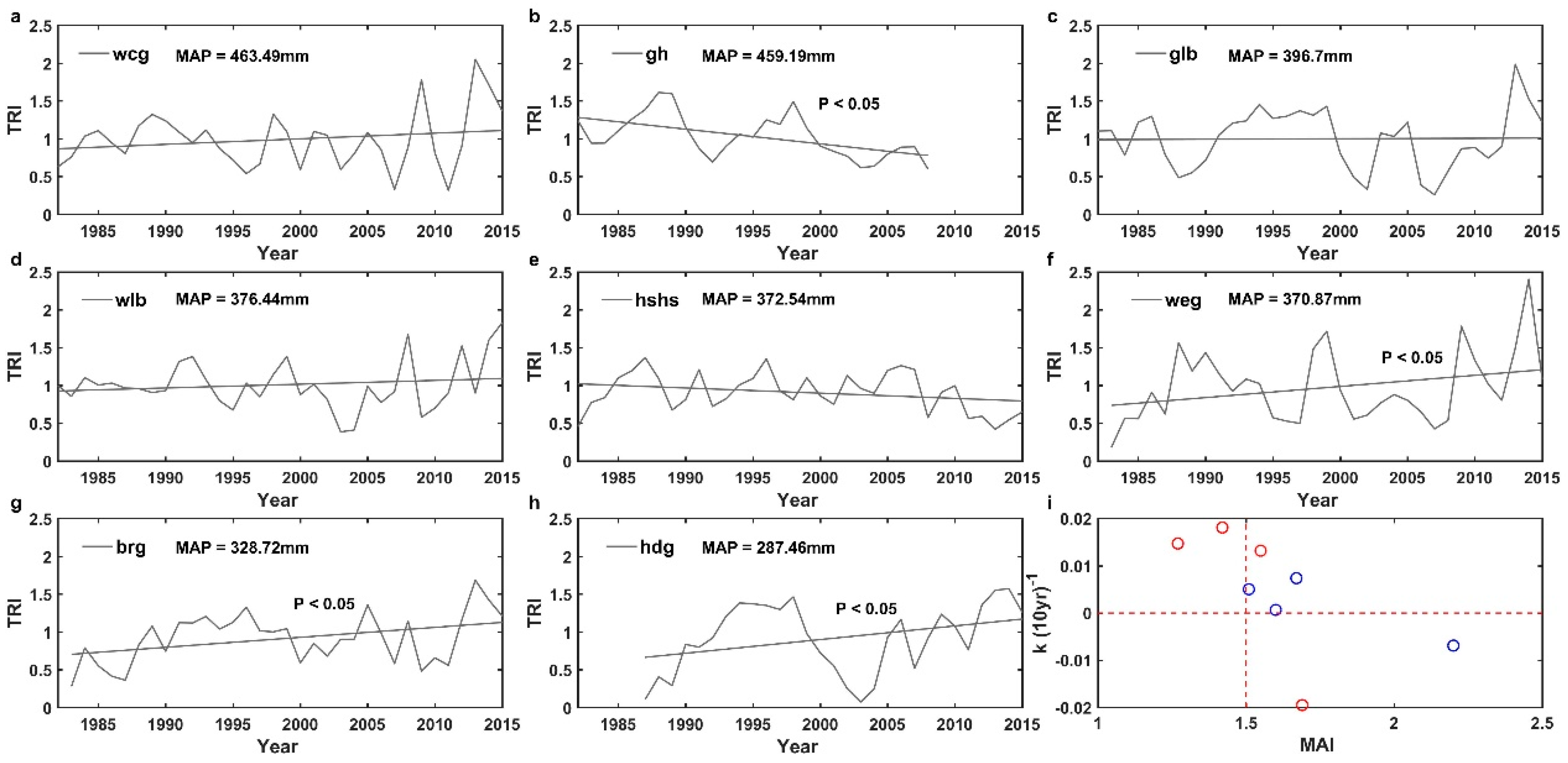
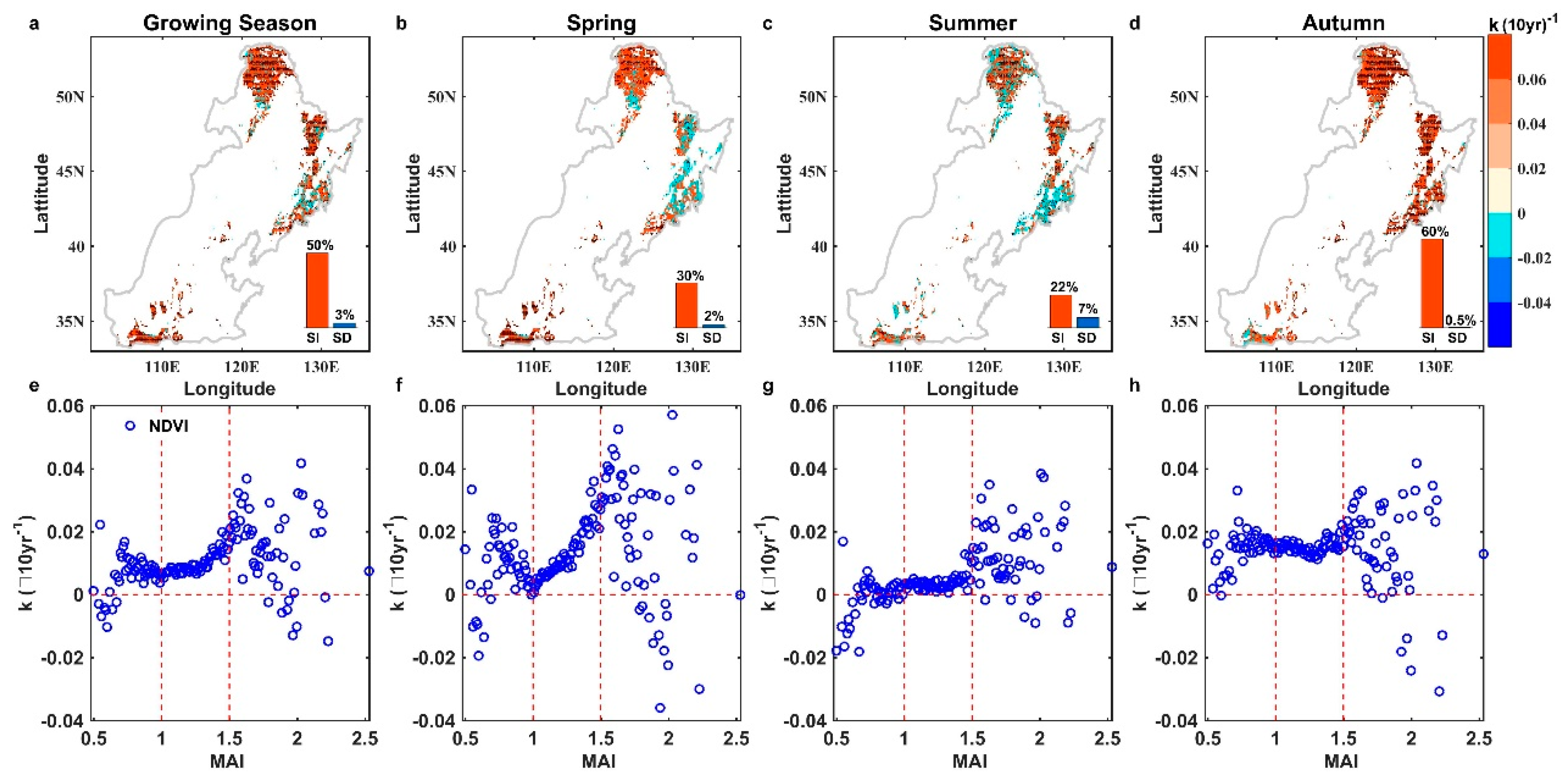
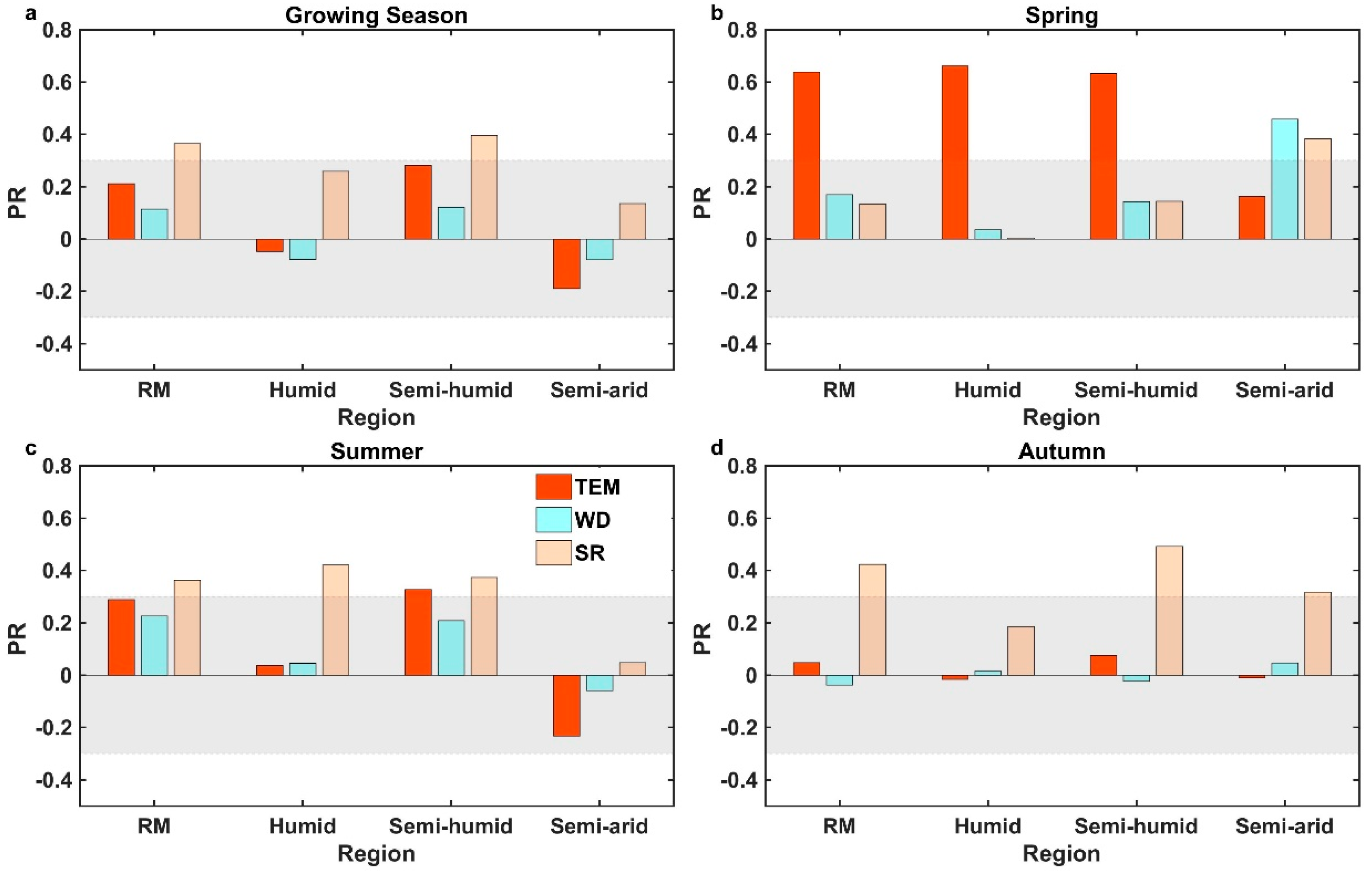

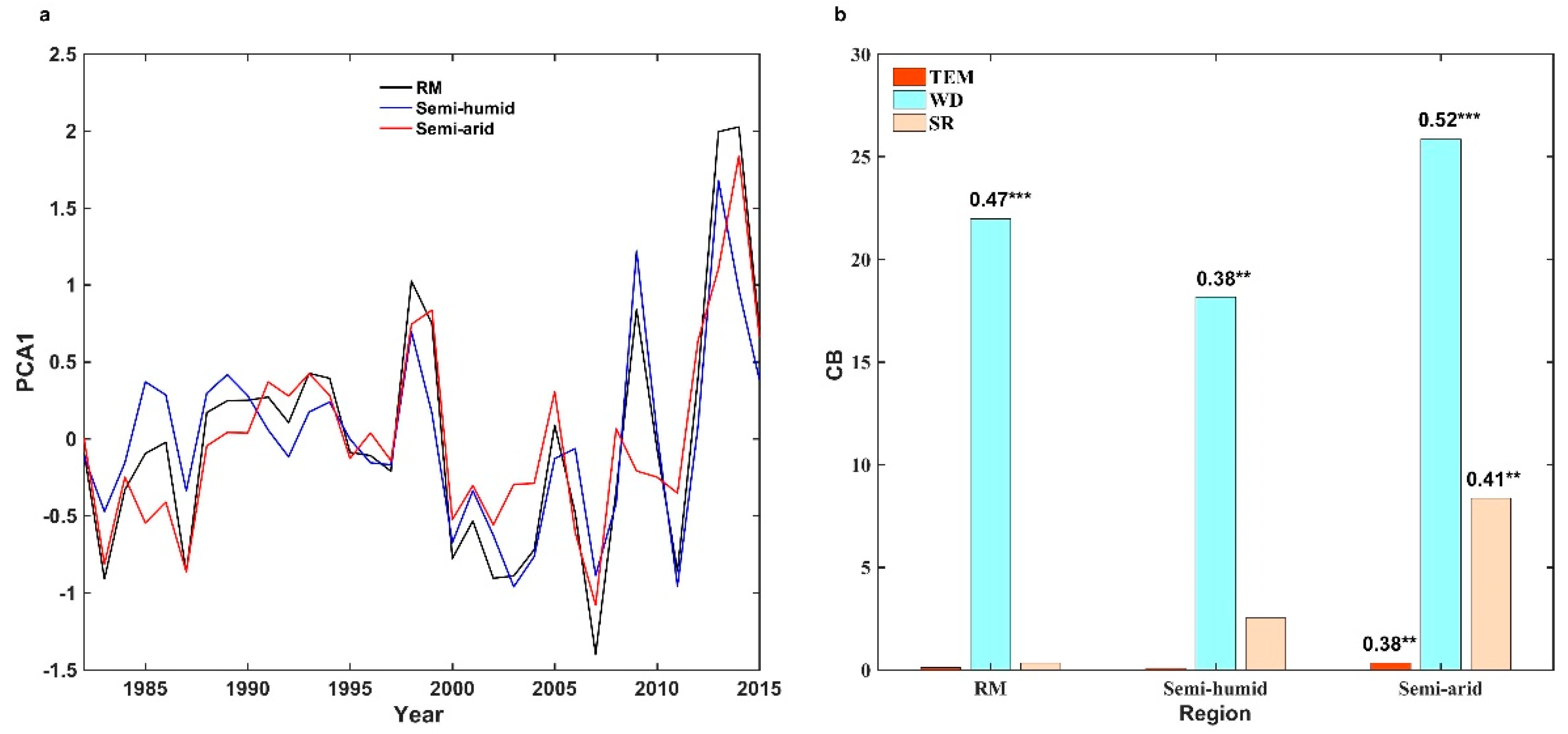
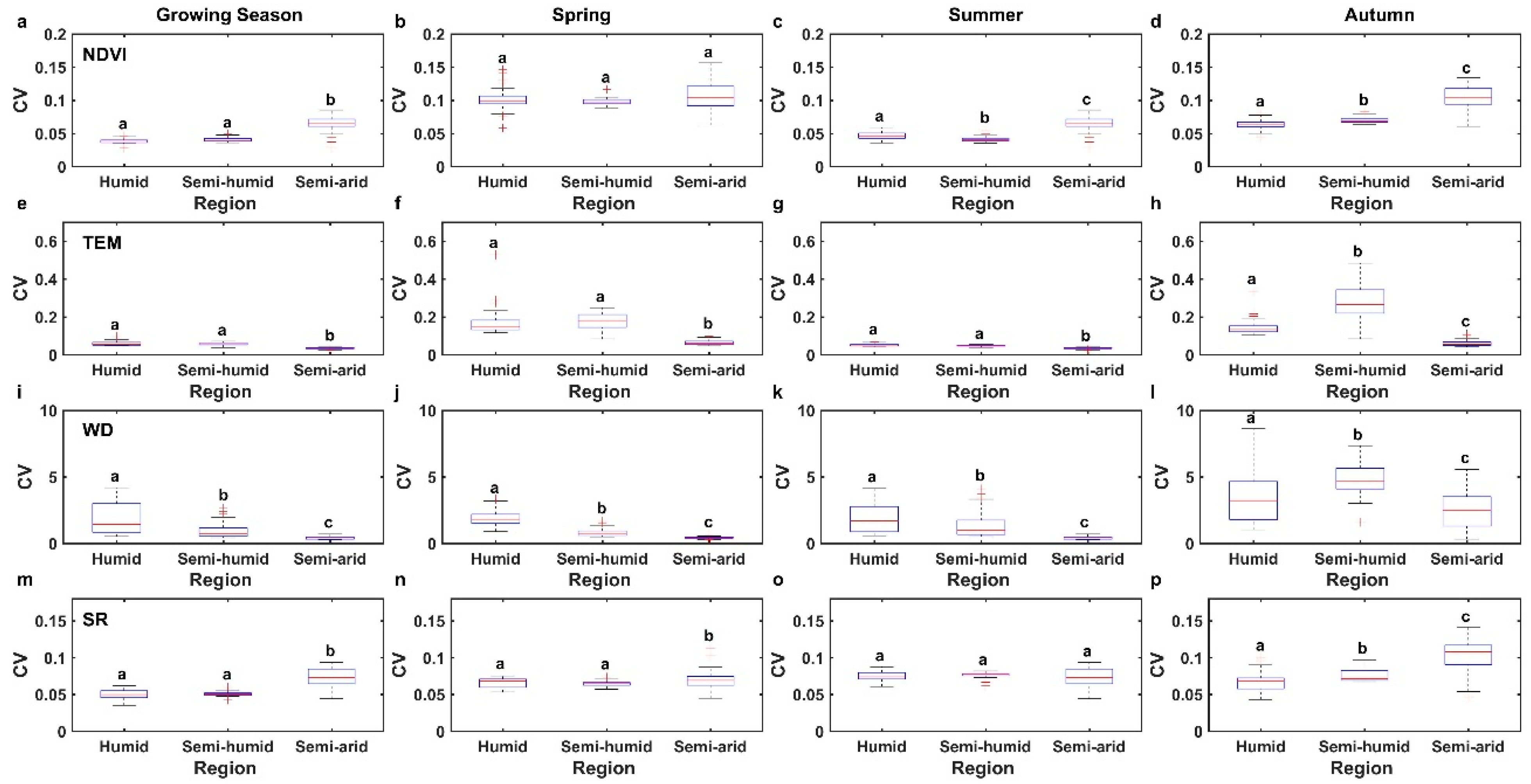
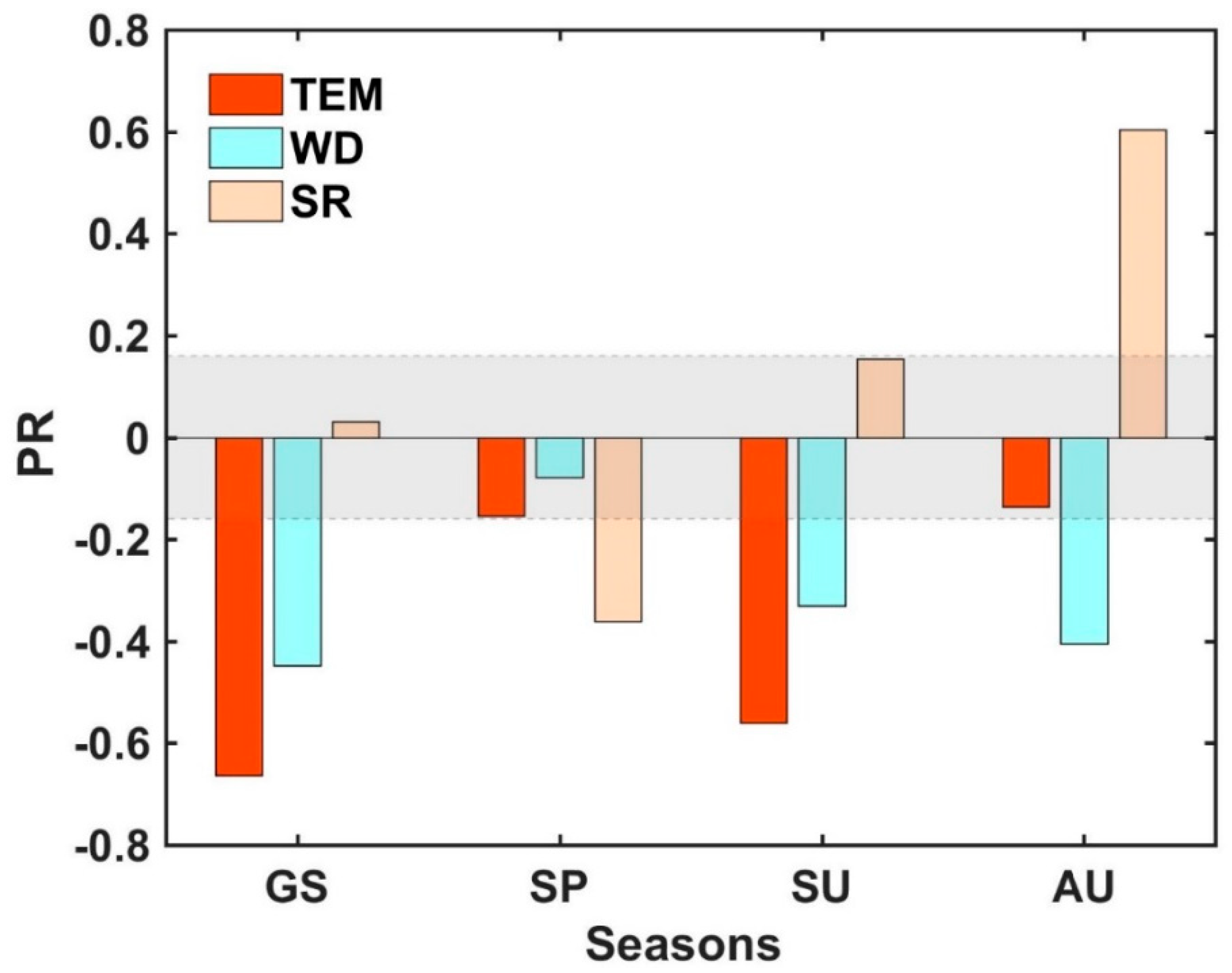
| Site | Species | Longitude | Latitude | Altitude | Slope | Coverage | Number of Trees | DBH | Tree Height | MAT | MAP | MAI |
|---|---|---|---|---|---|---|---|---|---|---|---|---|
| Code | (m) | (%) | (cm) | (m) | (°C) | (mm) | ||||||
| wcg | Larix gmelinii (Rupr.) Kuzen. | 120.30 | 46.78 | 850 | 12° | 40 | 79 | 20 | 9.1 | −2.22 | 463.49 | 1.67 |
| gh | Larix gmelinii | 121.43 | 50.74 | 714 | 0° | 35 | 27 | 27.6 | 14.5 | −3.98 | 459.19 | 1.69 |
| glb | Pinus tabuliformis Carr. | 111.49 | 40.56 | 1250 | 5° | 40 | 110 | 26.6 | 6 | 7.4 | 396.7 | 1.6 |
| wlb | Pinus tabuliformis | 119.18 | 44.66 | 964 | 10° | 28 | 71 | 24.2 | 11.7 | 6.02 | 376.44 | 1.51 |
| hshs | Larix gmelinii | 118.76 | 44.20 | 1857 | 25° | 40 | 77 | 25.3 | 13.3 | 5.16 | 372.54 | 2.2 |
| weg | Larix gmelinii | 120.61 | 50.39 | 620 | 3° | 40 | 87 | 17.8 | 9.9 | −1.92 | 370.87 | 1.27 |
| brg | Larix gmelinii | 119.14 | 44.78 | 1154 | 5° | 50 | 64 | 18.9 | 9.6 | 2.06 | 328.72 | 1.55 |
| hdg | Larix gmelinii | 119.69 | 47.34 | 885 | 5° | 20 | 43 | 18.6 | 10.5 | 0.75 | 287.46 | 1.42 |
| TEM (°C decade−1) | WD (mm decade−1) | SR (W m−2 decade−1) | NDVI (decade−1) | |
|---|---|---|---|---|
| GS | 0.329 *** | 3.529 | 0.822 | 0.009 *** |
| SP | 0.232 ** | 7.714** | −1.514 | 0.011 * |
| SU | 0.355 *** | −4.248 | 2.120 | 0.003 |
| AU | 0.387 *** | 0.063 | 1.212* | 0.015 *** |
© 2019 by the authors. Licensee MDPI, Basel, Switzerland. This article is an open access article distributed under the terms and conditions of the Creative Commons Attribution (CC BY) license (http://creativecommons.org/licenses/by/4.0/).
Share and Cite
Shi, F.; Wu, X.; Li, X.; Wang, P.; Yang, X.; Li, Y.; Jiang, X.; Pei, T.; Bai, Y.; Hao, B.; et al. Seasonal Divergent Tree Growth Trends and Growth Variability along Drought Gradient over Northeastern China. Forests 2019, 10, 39. https://doi.org/10.3390/f10010039
Shi F, Wu X, Li X, Wang P, Yang X, Li Y, Jiang X, Pei T, Bai Y, Hao B, et al. Seasonal Divergent Tree Growth Trends and Growth Variability along Drought Gradient over Northeastern China. Forests. 2019; 10(1):39. https://doi.org/10.3390/f10010039
Chicago/Turabian StyleShi, Fangzhong, Xiuchen Wu, Xiaoyan Li, Pei Wang, Xiaofan Yang, Yuanqiao Li, Xiaofei Jiang, Tingting Pei, Yan Bai, Bingyan Hao, and et al. 2019. "Seasonal Divergent Tree Growth Trends and Growth Variability along Drought Gradient over Northeastern China" Forests 10, no. 1: 39. https://doi.org/10.3390/f10010039





